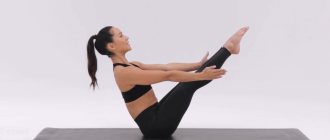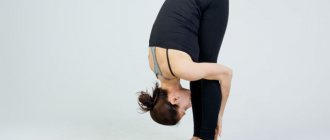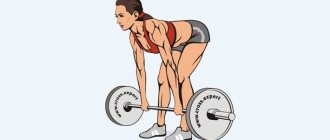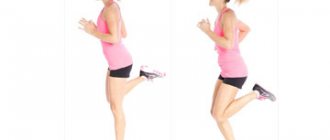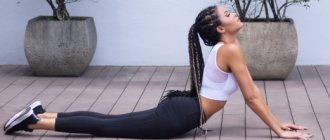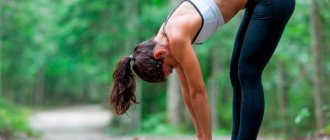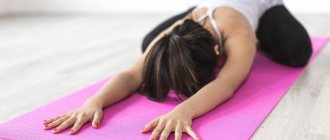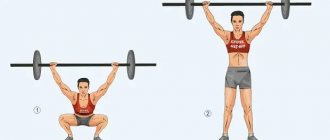vKontakte Facebook WhatsApp Twitter
When performed correctly, Urdhva Mukha Svanasana (Upward Facing Dog) heals the spine, strengthens the back muscles and stretches the back. How to achieve the healing effect of asana? Please read this article carefully. Remember all the stages of entering the asana and typical mistakes. If necessary, bookmark this article. This will allow you to return to the description of the execution technique at the right time.
Execution technique
Step 1:
Lie face down on the floor.
Spread your feet 20-25 cm apart, toes pointing back. Actively extend your legs back, knees tucked, and the backs of your feet flat on the floor.
Bend your elbows and place your palms on the floor on the sides of your body - at waist level; your forearms should be relatively perpendicular to the floor. The fingers look strictly straight. The chin should be forward.
Step 2:
Inhale and press your palms firmly into the floor, stretching them out and back slightly, as if you were trying to propel yourself forward along the floor. Then, as you inhale, straighten your arms and at the same time lift your body and legs a few centimeters from the floor.
Keep your thighs firm and roll them slightly inward. Tighten your arms and turn them outward a little so that your elbows point straight back and not to the sides.
Step 3:
Squeeze your shoulder blades together and pull them down, pulling your sides forward in the chest area. Stretch your entire chest upward, but don't push your front ribs out, this will only block your lower back from further stretching.
Look straight ahead or tilt your head back slightly. Do not pinch the back of your neck or strain your throat; to do this, actively move your shoulders back and down, following your shoulder blades.
Step 4:
Stay in the pose for 15-30 seconds (a couple of breathing cycles).
Tuning
It is important to consider the following nuances:
- when straightening your arms, the entire surface of your palms rests on the floor;
- keep your head in a level position, without tilting it back, your chin can be slightly lowered;
- Press the insteps of your feet to the floor surface, pull your toes away from you;
- the chest is directed forward;
- Do not pinch the sides of the ribs with your hands.
Attention! To open the chest as much as possible, it is important to monitor the position of the shoulder joints: they need to be lowered down and brought back, moving the shoulder blades together.
Breathing should be slow and even. Shallow, rapid breathing indicates improper execution of the exercise.
Do not twist your elbow joints. For beginners, you can perform the pose with your arms slightly bent at the elbows.
Exit from the pose
As you exhale, curl your toes, bend your elbows, and gently lower your hips and torso to the starting position while lying down.
If you are doing Urdhva Mukha Svanasana as part of the Surya Namaskar (Sun Salutation) sequence, then the next asana will be Adho Mukha Svanasana (Downward Facing Dog).
As you exhale, curl your toes (by jumping or rolling over your toes), and as you inhale, smoothly return to Chaturanga Dandasana (Staff Pose) and then rise to Adho Mukha Svanasana.
Advice from an expert
View this post on Instagram
✅Upward Facing Dog Pose - Urdhva Mukha Shvanasana #howto_evgeshayoga ⠀ This asana will help you stretch the front surface of the body, as well as open the chest and shoulder girdle. ⠀ But if they are clamped enough, then the blow may fall on the lower back, as evidenced by a strong crease and even pain. How to avoid this: ⠀ 1️⃣ Lower your knees to the floor and concentrate on stretching, as if pushing your palms towards the pelvis without displacing them. Don’t be afraid to bend your elbows, gradually opening your arms to straighten. Here we learn to keep the stomach active without sinking in the lower back. ⠀ 2️⃣ Knees above the floor. This variation may be more difficult to hold your lower back without compression, so approach it after learning the first one with gradual practice. Try to straighten your arms as you open your chest and push your body up out of your arms. ⠀ This asana may be difficult and sweaty, but it shouldn’t hurt! Pain in the lower back and neck is a signal to look at the details and possibly adjust the technique to suit you. ⠀ Does anyone feel pain in their deflections? Which ones exactly? ⠀ ___________________________________ The last TWO days of registration for the course “Summer with Yoga” and even with
